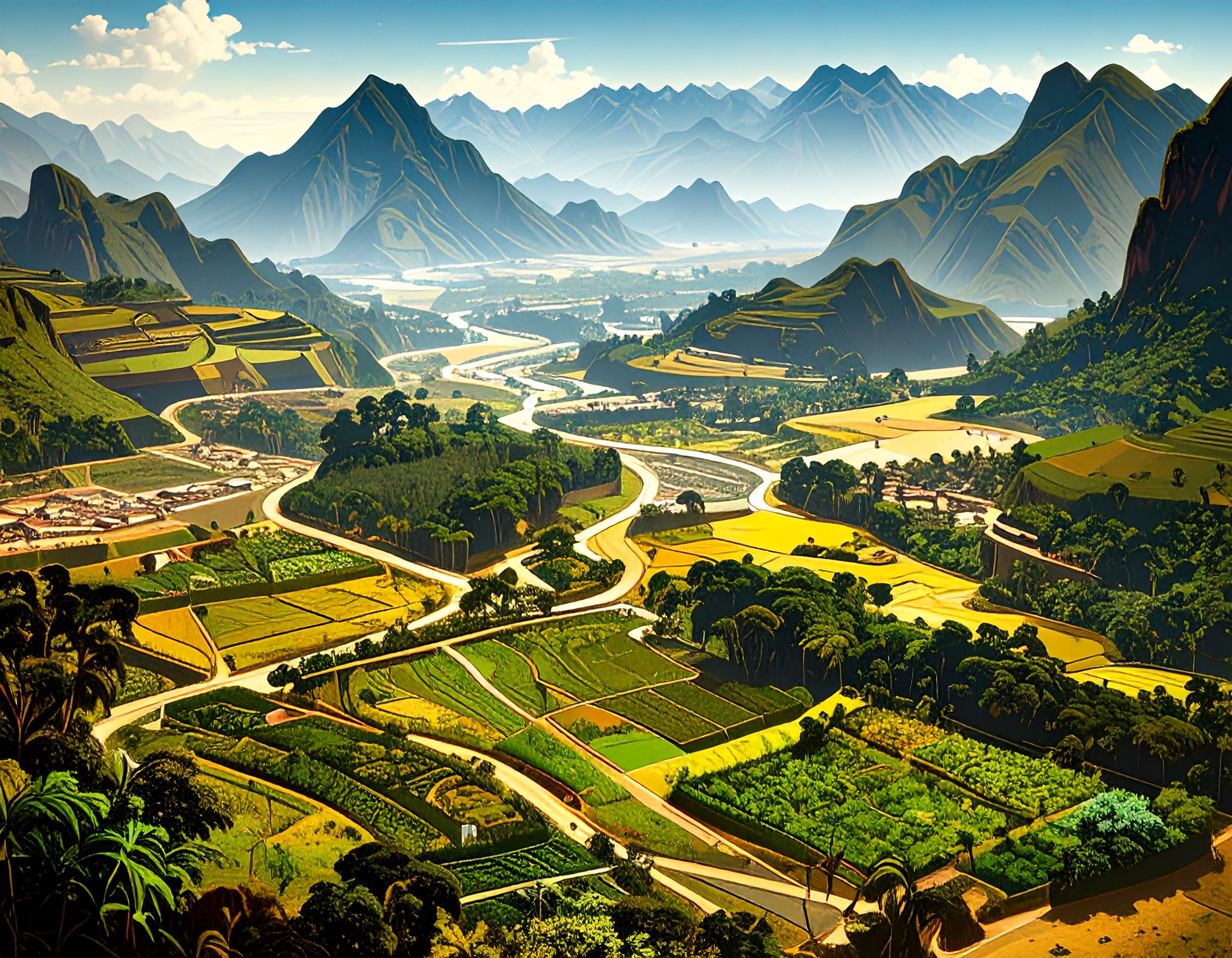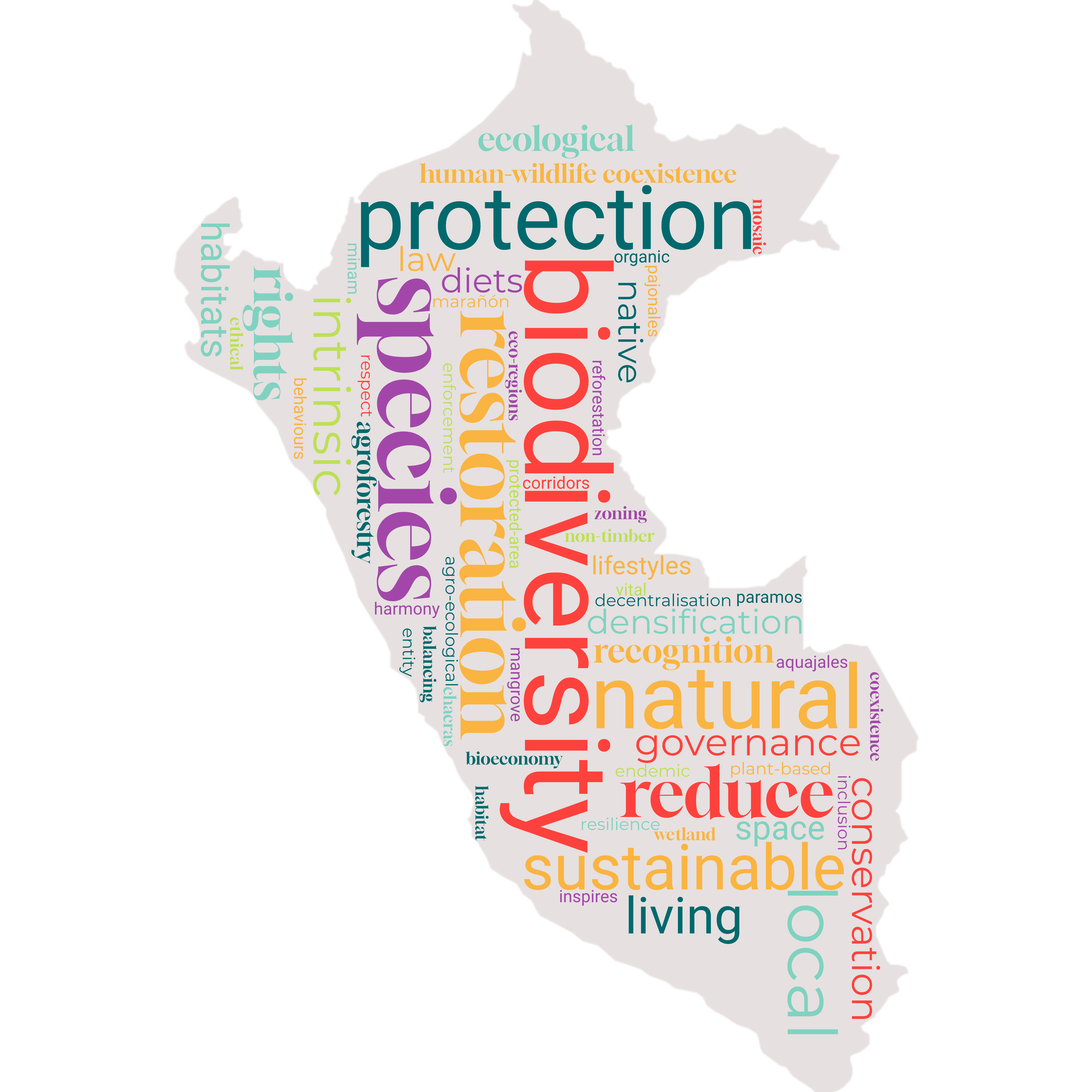Nature for Nature
By 2060, Peru’s landscapes are treated as vital, living entities deserving of protection not merely for their utility to humans but for their inherent worth. This transformation was sparked by a societal shift in the early 21st century, towards recognizing nature’s intrinsic value as a fundamental aspect of ethical living. This vision reshaped economic, social, and environmental governance priorities, aligning them with an ethos of coexistence and respect for life in all its forms.

Characteristics
 Climate Change: RCP 2.6
Climate Change: RCP 2.6
 Population: 37.21 million
Population: 37.21 million
 Economic development: 1007 billion USD
Economic development: 1007 billion USD
 Value perspective on nature: Mainly Intrinsic
Value perspective on nature: Mainly Intrinsic
 Protected areas (proportion of Peru under protection): 30% by 2030
Protected areas (proportion of Peru under protection): 30% by 2030

Shifting Values and Lifestyles
Witnessing first-hand the continued degradation of nature and the decline of characteristic species1 due to climate change and anthropogenic activities inspires a profound shift in societal values. Nature is no longer seen as a resource to be exploited but as a partner in a shared existence. This perspective is enshrined in law, building upon the legal precedent of the recognition of the Marañón river as an entity holding intrinsic rights, including the right to exist and the right to be free of pollution2. This concept of rights for nature is propagated through education initiatives to improve widespread environmental awareness among the population.
1 https://news.mongabay.com/2018/11/extinction-by-omission-perus-disappearing-ancient-shihuahuaco-trees/)
2 https://www.internationalrivers.org/wp-content/uploads/sites/86/2024/03/Maranon_Nota-de-Prensa-Local_19-Marzo-2024.pdf
In terms of lifestyles changes, the population adopts resource efficient behaviours to reduce the impact on nature. The share of the population living in urban areas reaches 92% by the year 2060 ((1), according to SSP1) with people opting to live in compact settlements that provide better access to services and amenities. There is also a substantial shift in diets towards more plant-based consumption to reduce pressure on ecosystems through livestock production3. The recognition of the intrinsic value of nature fosters wider societal inclusivity, which drives progress in reducing economic and social inequality, by, for example, addressing issues such as the disproportionate employment of women in the informal sector (2).
Changing economic priorities
Economic development shifts towards sustainable activities in secondary urban centres beyond Lima, promoting local, eco-friendly businesses and reducing dependence on resource-intensive industries. This transition enhancing community resilience (3) and results in increased economic formalisation which generates revenue for greater governmental spending on nature protection as this is recognised as essential for the continuation and growth of the green economy4. Overall, there is moderate economic growth, with GDP per capita reaching approximately 1007 billion USD by 2060 (converted to USD using purchasing power parity (PPP) in 2017), as projected under SSP2 (4).
4 https://oxfordbusinessgroup.com/reports/peru/2017-report/economy/in-the-open-a-new-strategy-is-in-place-to-help-more-workers-move-to-the-formal-sector
The agricultural sector adopts techniques that emphasize harmony with nature such as agroforestry and agro-ecological farming (chacras agroecológicas integrales) (5,6). The organic agriculture sector expands with pesticides and synthetic fertilizers are replaced by natural alternatives, ensuring long-term productivity of the soil. However, these changes make agricultural production more extensive, requiring greater land area to meet food production demands. At the same time, the reduction in land utilised for livestock as a response to changing diets, does counteract this trend to an extent. To further reduce environmental impacts agricultural land is situated in closer proximity to urban areas to reduce length of the supply chain and hence minimize wastage.
Forestry policies are characterised by strict protection and restoration measures (7). Clearance of natural forests is heavily restricted, and production forests are required to shift towards native species over non-native high yield species. Similarly mining activities are strictly regulated, with no new concessions being granted beyond 2030, however existing operations are allowed to continue (8). However, due to stringent legal environmental requirements, only a limited portion of these concessions are exercised by the holders, minimizing the overall environmental impact. Tourism shifts towards nature-focused activities such as wildlife watching, forest and wetland walks, and marine conservation tours, actively promoting a more sustainable and respectful relationship with nature (9).
Indigenous Communities
The wellbeing of Indigenous communities is improved through the strengthening of land rights, increased political representation, and participation in conservation efforts. In this regard, the role of Indigenous communities as environmental stewards is formally recognised in the expansion of protected areas with the inclusion of indigenously managed reserves (10). However, stricter land-use regulations do occasionally create tensions where communities seek to maintain traditional agricultural or resource use practices. In addition, there are targeted policies improve access to healthcare, education, and economic opportunities (11).
Governance, Planning and Resource Management
Governance evolves to ensure transparency and effective regulation of activities impacting ecosystems, particularly the strict control of environmental pollution. The primary focus of landscape planning is minimising human impacts on nature. For example, when planning developments authorities must give equal consideration to the impacts on people and nature in accordance with the rights of both. In light of this, the 2023 modification to the Forest and Wildlife law5 is repealed and responsibility for forest zoning is returned to MINAM. Alongside this, the contracts of existing forest concessions are allowed to expire after their initial 40-year terms. Concession management is then aligned with a nature-first principle such that only operators demonstrating robust ecological stewardship have their concession contracts renewed. Non-renewed concession areas remain under state management and support sustainable activities like low-impact nature-focused tourism or community-led agroforestry.
5 https://idehpucp.pucp.edu.pe/boletin-eventos/derechos-humanos-obligaciones-internacionales-y-deforestacion-de-la-amazonia-analisis-de-las-modificaciones-en-la-ley-forestal-y-de-fauna-silvestre-desde-el-derecho-internacional-29070/#_ftn13
Urban areas throughout Peru are better planned for sustainability, with a trend towards overall densification whilst maintaining integrated green spaces. This ensures that there is less arbitrary sealing of natural surfaces (soil) in urban areas (12). The development of transport and communications infrastructure is mindful of the need to minimise ecological impact, with strategic road expansions that avoid sensitive areas to protect natural habitats and biodiversity. Better enforcement of the law prohibits illegal road construction in ecologically valuable areas (13).
In terms of water resources, the hydrographic network is carefully managed to ensure water courses follow natural dynamics. Initiatives aimed at using water more efficiently help to conserve the water needed for natural ecosystems to thrive (14), while governance frameworks enforce strict water conservation measures, preventing over-extraction and pollution of rivers, lakes, and aquifers. Water infrastructure development focuses on nature-based solutions, such as wetland restoration and watershed protection, to enhance water retention and quality (15). Strengthened regulatory oversight reduces illegal water diversion, while community-led water stewardship initiatives empower local actors to participate in sustainable resource management.
Ecological Restoration and Protection
In line with the notion of the need for areas for nature to thrive free from human impacts, there is a strong push to expand conservation areas to cover 30% of the national territory by 2030 with existing conservation areas and their management still persisting. Sites for new conservation areas are chosen on the basis of their value for preserving biodiversity whilst balancing the inclusion of Peru’s diverse eco-regions. These areas typically lie further from settlements to mitigate human-wildlife conflicts. Therefore, they are often designated as government-managed strict protected areas (e.g. National Parks) where human activities inside core areas are strictly managed according to the IUCN category Ia or Ib6. However, a proportion of the new conservation areas are also established as indigenous-led biodiversity reserves with defined core and sustainable use areas. Environmental research within conservation areas is directed towards understanding how to maintain and restore biodiversity. In the wider landscape there are large-scale environmental restoration programs with the goal of restoring degraded areas to functioning natural habitats. Additionally, a large effort is made to limit the introduction of non-native species to safeguard endemic biodiversity (16).
6 https://es.wikipedia.org/wiki/Categor%C3%ADas_de_%C3%A1reas_protegidas_de_la_UICN